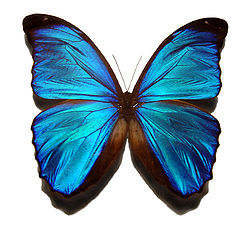The Morpho butterfly is a singularly beautiful blue impossible for artists to reproduce with pigments as the colour is due to nanostructures which cause the wing’s unique optical properties. (Image copied from Wikipedia essay on Morpho butterflies.)
The butterfly has excited a lot of interest in the nanotechnology field and this morning (Jan. 17, 2011) research scientists (Clint Landrock and Bozena Kaminska) based at Simon Fraser University (Vancouver, Canada) announced that in an effort to eliminate currency fraud they have found a way to duplicate the butterfly’s optical properties on paper currency. It all starts with holes (from the Jan. 17, 2011 news release),
Imagine a hole so small that air can’t go through it, or a hole so small it can trap a single wavelength of light. Nanotech Security Corp., with the help of Simon Fraser University researchers, is using this type of nano-technology – 1,500 times thinner than a human hair and first of its kind in the world – to create unique anti-counterfeiting security features.
…
How this works is microscopic gratings composed of nanostructures interact with light to produce the shimmering iridescence seen on the Costa Rican morpho butterfly. The nanostructures act to reflect and refract light waves to produce the morpho’s signature blue wings and absorb other unwanted light.
The highly advanced wing structures are the result of many millennia of evolution, and only recently have Nanotech’s scientists discovered how to reproduce these structures reliably. While others have talked about the possibility of re-creating it, Nanotech has made this a reality.
The U.S. Treasury, which produces up to 11 billion banknotes annually, is a potential customer for Nanotech’s product. The new U.S. $100 bill, designed with state-of-the art security features, was supposed to be introduced in February 2011 but it’s been delayed due to some manufacturing issues.
…
According to Blakeway [Doug Blakeway, SFU Venture Connection’s entrepreneur in residence and also CEO and chairman of Nanotech Security Corp.], Nanotech’s product – which has attracted the attention of treasuries internationally – is superior to holograms and can’t be duplicated.
“Nobody has ever done this,” he said. “We have succeeded while everybody is still trying to duplicate or imitate a butterfly’s wing because it absorbs light and gives off the color. There’s no color pigment – there’s nothing like a dye or anything else. It’s a hole that traps light and releases color.
“You can’t copy or scan it in, you can’t inkjet it on paper, you can’t do any of these things. It’s extremely sophisticated and expensive to make the shims and dyes to produce, but very inexpensive to produce it at the end. Anywhere you can think of where a hologram is being used today, our technology can replace it. It’s more secure than a hologram. You can’t lift it off – we can put it onto metal, plastic, or paper.”
There is a video clip of a Discovery Planet item about the scientists’ presentation at the recent Las Vegas Consumer Electronics Show. (Note: The clip is about 11 minutes long and the ‘Morpho’ money item is partway through.)
I’m a little puzzled about whether or not this is really the first time (as Nanotech Security Corp. claims) someone else has been able to reproduce the butterfly’s optical properties since there is a company in Japan, Teijin, which produces ‘Morphotex’, a textile that has the same properties as the butterfly. This was mentioned in my July 19, 2010 posting which also features an image of Donna Sgro’s dress made from the textile.
